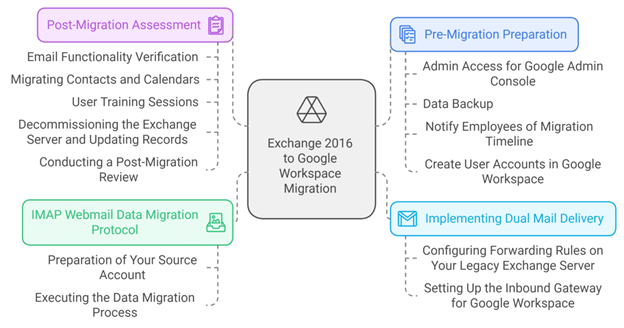How to Migrate from Exchange Server 2016 to Google Workspace?
Advances – whether in technology, knowledge, or workflows – drive progress. Business organizations operate by this maxim and invest a lot of resources into keeping up with evolving technological trends. Cloud technology, although by no means new, is a powerful platform that improves the accessibility, scalability, and flexibility of software solutions and computational resources. Cloud-enabled technologies are still making waves in the business landscape, nearly 20 years after establishing the modern framework we recognize today. The downside of having to constantly evolve, however, is letting go of the past, which is much harder to do when we are talking about digital services that are integral to business functioning.
As businesses flourish and expand, their needs also start to scale, requiring more comprehensive solutions. Such a shift was seen when Microsoft launched the 2019 edition of Exchange on-premises servers. People started migrating from their 2016 Exchange servers to the latest edition to keep up with the latest technological trends. Those of you still stuck with Exchange 2016 should consider upgrading to a more updated and comprehensive platform that is ideal for modern business communication and pushes the boundaries of business productivity. Google Workspace is an excellent cloud-based choice for those of you who haven’t yet decided which service to choose.
The upcoming sections of this blog post will cover the benefits of Google Workspace over Exchange 2016 and the steps to migrate your data from the on-premises service to the cloud one.
Google Workspace vs. Exchange 2016: Why Workspace is the Superior Solution
The following table will help compare Google Workspace and Exchange 2016 across several criteria.
| Aspect | Google Workspace | Exchange 2016 |
| Cost | Subscription-based model with predictable budgeting | Significant upfront investment in hardware/software |
| Maintenance | Handled by Google, reducing IT workload | Requires dedicated IT staff for ongoing maintenance |
| Scalability | Highly scalable, easy user and storage adjustments | Complex scaling requiring additional hardware/software |
| Flexibility | Accessible from any device with internet connection | Primarily accessible within the organization’s network |
| User Interface (UI) | Modern, user-friendly, easy to navigate | Less intuitive, requiring more training |
| Collaboration Tools | Seamless integration with Google Drive, Docs, Meet | Limited collaboration features compared to Google Workspace |
| Email Storage | Generous cloud storage with no limits on email size | Storage limits imposed, additional storage costs may apply |
| Security | Robust built-in security features | Dependent on organization’s IT policies |
| Disaster Recovery | Automatic backups and quick restoration | Requires self-implemented backup and recovery solutions |
| Integration with Other Services | Easy integration with third-party applications | Limited integration, may require additional configuration |
| Updates and Upgrades | Regular automatic updates | Manual updates required, potentially leading to downtime |
| Support | 24/7 support included in subscription | Typically handled internally, may require contracts for support |
Workspace is clearly the better option for businesses that are looking to migrate to a more modern and feature-rich service that does not come with a steep learning curve.
Prerequisites for Migration from Exchange 2016 to Google Workspace
The process of migrating from one service to an entirely new one is bound to be hard, both for the end users and the administrators handling the transition. If you are uncomfortable or do not have the technical expertise to handle the migration, seeking assistance from seasoned professionals is highly recommended. Partnering with experts like Apps4Rent can facilitate a seamless and efficient transition, with minimal disruptions and optimal results. Regardless of whether you connect with professionals for the migration or have decided to handle it in-house, following certain pre-migration steps are absolutely essential for a smooth transfer. The following steps outline the most important prerequisites for migrating from Exchange 2016 to Workspace.
- The Google Admin Console is pivotal in facilitating the migration. Without the appropriate administrator access, users will be unable to start or oversee the transition. The console enables users to configure migration settings, establish and manage user accounts (another essential pre-migration step), and supervise the entire process.
- The intricate nature of the migration process increases the risk of errors and interruptions due to misconfigurations. This can potentially result in data loss and hinder operational continuity, making it highly advisable to back up essential information prior to the migration.
- Most businesses are bustling places, with employees running to meetings while juggling numerous tasks. It is a wise call to select a migration timeframe when employee engagement is at its lowest to ensure reduced operational downtime. Inform employees about the migration schedule, allowing them sufficient time to wind up or halt important tasks and make the necessary preparations for the migration.
- Setting up user accounts before migration allows employees to access their Google Workspace accounts and data as soon as the process is completed. If user accounts are not created beforehand, the data migrated from Office 365 will lack a designated destination, which could cause delays and complications during the transition.
- Log in to the Google Admin Console using an administrator account.
- In the Admin Console, navigate to Menu > Directory > Users.
- Click on “Invite New User” or “Add New User” at the top of the page.
- Fill out the form with the required information so the new user can either invite them or create their account.
- Repeat this procedure for each user you wish to include in your Google Workspace.
Steps for Migrating Data from Exchange 2016 to Google Workspace
When transitioning from one service to another, several methods and tools are available. This document details a manual approach to implement dual mail delivery for your Exchange and Google Workspace mailboxes. This strategy provides sufficient time for testing the migration process and helping users adapt to the Google environment before finalizing the migration and decommissioning Exchange services.

Implementing Dual Mail Delivery
This approach allows organizations to maintain their legacy Exchange 2016 as the primary mail server while concurrently configuring Google Workspace (Gmail) for email delivery. This method is particularly effective for piloting Gmail with a selected group of users during the transitional phase.
As you integrate Google Workspace, you can retain your legacy Exchange server as the primary server. This is beneficial for assessing Gmail functionalities with a limited user base prior to a complete migration.
Important Note: At this stage, it is crucial not to alter your MX records to direct emails to Google. Maintaining the legacy server as the primary mail server is vital for this configuration.
Ensure you have the necessary credentials for your domain provider, including your username and password, to set up server-based forwarding properly.
-
Configuring Forwarding Rules on Your Legacy Exchange Server
- Begin by setting up forwarding rules on your Exchange server. This configuration will ensure that incoming emails are first directed to the legacy server, which will subsequently forward them to Gmail.
- Log in to the management console of your domain host and navigate to the area designated for managing MX records associated with your domain.
- Confirm that your MX records are still directed toward the legacy mail server to ensure proper email routing.
- Next, configure the legacy server to forward all incoming emails to ASPMX.L.GOOGLE.COM, the primary Google mail server.
-
Setting Up the Inbound Gateway for Google Workspace
To establish an inbound gateway:
- Log in with an administrator account (do not use a personal email).
- In the Admin console, navigate to Menu > Apps > Google Workspace > Gmail > Spam, Phishing, and Malware. Choose your primary organization from the left sidebar and click Edit under the Inbound Gateway setting.
- Click Add to access the IP address/range configuration box. Enter the public IP address or range associated with your gateway, then select Save.
- At the bottom of the settings page, click Save to apply your changes. Note that changes may take up to 24 hours to take effect, though they typically occur sooner.
- Once the Time to Live (TTL) for the MX records has expired, send a test email to a user within your domain to verify that messages are processed correctly and appear in the intended recipient’s inbox.
- Additionally, send test emails to the legacy server addresses of users to confirm functionality. Ensure recipients can access these test messages in both their legacy inbox and their new Gmail inbox.
Overview of the IMAP Webmail Data Migration Protocol to Google Workspace
-
Preparation of Your Source Account
- Confirm that the EWS ports are open and accessible on your server.
- Create a dedicated migration role account and assign it impersonation rights.
-
Executing the Data Migration Process
To configure the data migration in the Google Admin Console, follow these steps:
- Sign in to your Google Admin Console using an account with super administrator privileges.
- Navigate to Menu > Data > Data Import & Export > Data Migration.
- Select the option to Set Up Data Migration.
- Under Migration Source, choose Other IMAP Server.
- Verify that Email is selected as the data type.
- In the Connection Protocol section, select IMAP and enter your IMAP server’s name in the Server URL field (e.g., imap.example.com).
- For the Role Account, input the email address and password associated with your designated role account.
- Click Start to initiate the setup.
- For the Migration Start Date, accept the default date or select a specific date to commence the migration.
- For Migration Options, either accept the default settings or specify any data you wish to exclude from the migration.
- Click on Select Users to proceed.
- Choose the Bulk Upload with CSV option.
- Click Attach File to upload your migration CSV file, which should list both the legacy email addresses and their corresponding new Google Workspace email addresses.
- Click Upload, followed by Start Migration to begin the migration process.
Final Steps in the Exchange 2016 to Google Workspace Migration Process
- Email Functionality Verification: Confirm that emails are correctly flowing to Google Workspace accounts and that all necessary configurations are functioning as intended.
- Migrating Contacts and Calendars: If contacts and calendar events have yet to be migrated, export them from your Exchange Server and import them into Google Workspace. This task can be complex and may require advanced technical skills. Fortunately, Apps4Rent’s migration specialists can facilitate this process and simplify your Exchange Server 2016 to Google Workspace migration.
- User Training Sessions: Organize training sessions for users to help them familiarize themselves with the features of Google Workspace.
- Decommissioning the Exchange Server and Updating Records: Once all data has been successfully migrated and users are comfortable with Google Workspace, prepare for the decommissioning of the Exchange server. Updating MX records to direct emails to Google’s servers is one of the final steps in your transition to Google Workspace.
- Conducting a Post-Migration Review: After everything is set up, conduct a thorough review of the migration to address any user concerns or issues that may arise.
Why Choose Apps4Rent for Google Workspace to Exchange 2016 Migration Assistance
Apps4Rent is a trusted Google Cloud Partner and has handled thousands of migrations for several organizations, optimizing their digital workflows and enhancing overall business productivity. Even the best-laid plans can fail without the right technical expertise, resulting in possible data loss or extended interruptions to essential business functions. As such, collaborating with a reliable expert such as Apps4Rent is vital for managing important IT tasks like migrations.
Our cloud experts will ensure that your migration is executed seamlessly and will be tailored to your business needs. From initial pre-migration assessment to 24/7 support post-migration, we at Apps4Rent are committed to guiding you through the Exchange 2016 server to Google Workspace migration process.
Contact our dedicated customer support team over chat, call, or text to learn more about how we can simplify your Google Workspace migrations.



